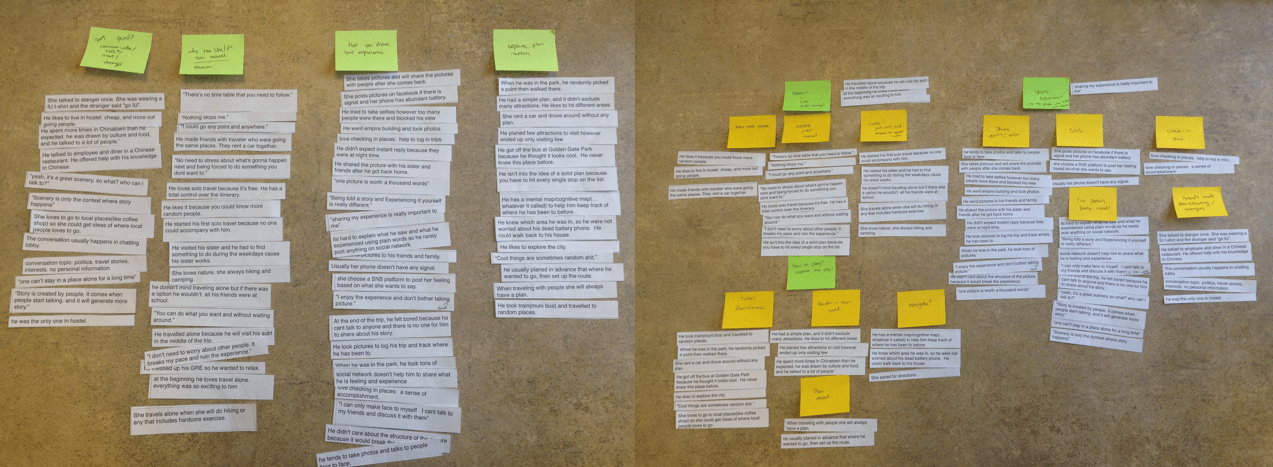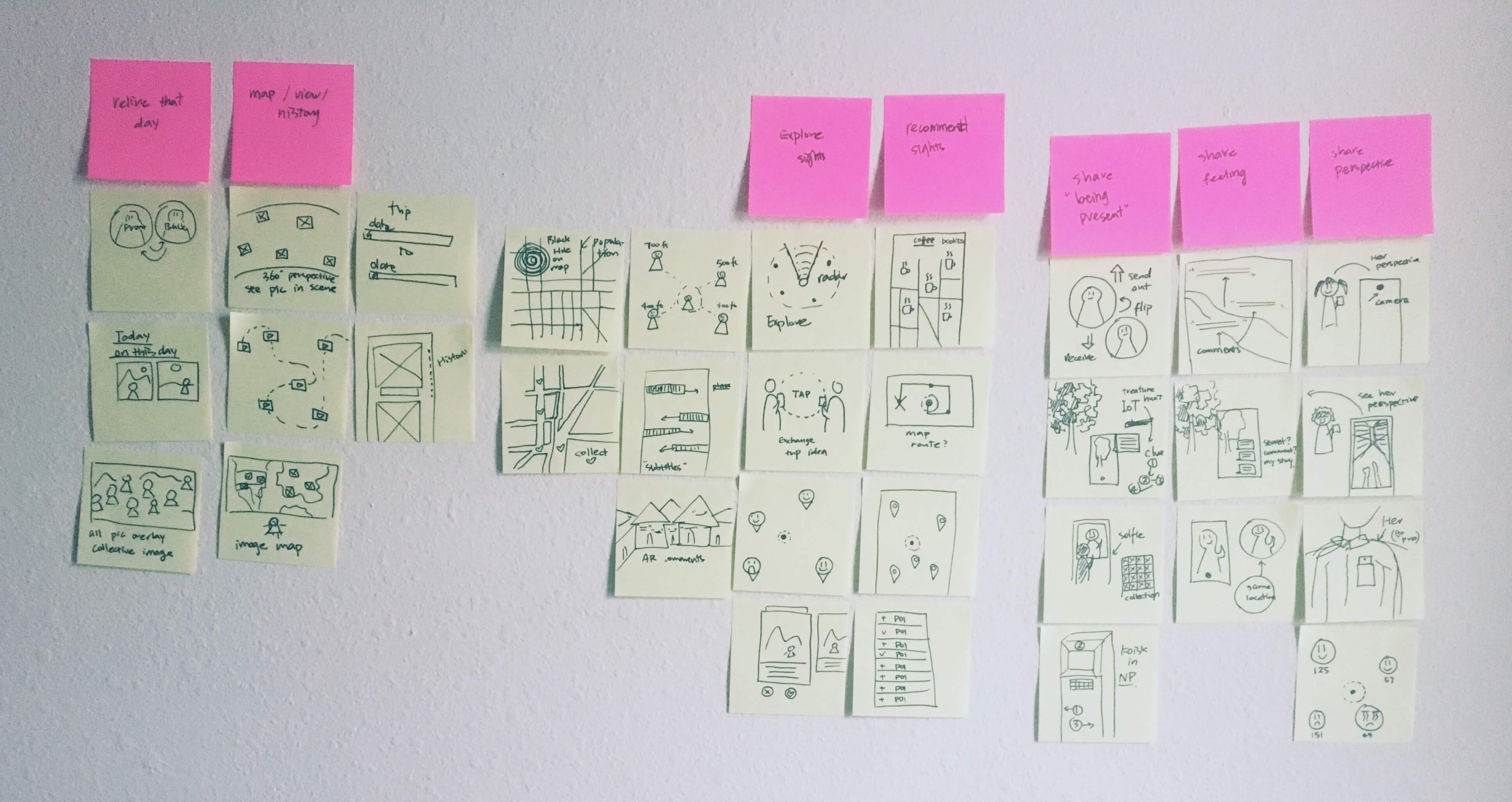

Serendipity
Reimagine the solo traveling experience
According to a research run by TripAdvisor, in 2015, 25% of millennials show interest in solo travel. It’s undeniable that solo travel has become a new fab and it has countless benefits: we all need a little alone time to order our thoughts, reflect on who we really are and what we are capable of. However, it's no sweat at all to name a list of fears that might stop people from hitting the road. Except from the safety issue, top biggest concerns are, “will I feel lonely?” and "will I get bored?".
When traveling alone, sometimes the only companion traveler has is the mobile phone. With the rapid evolving mobile technology, what can we do to enrich traveler's adventure without interrupting the unique experience flow?
RESEARCH
Methods: Content Analysis, Interview, Diary Study
Thoughts on Choosing Research Methods
In the heart of user centered design, the first step is to truly understand the users and their solo travel experience. Given that this experience is relatively private to an individual, a lot of conventional user research methods such as field observations and contextual interview seems inappropriate(unless I don’t talk to people in field observation) and might get biased result in this situation. Therefore the balance between the need of understanding the user group and (to the most extent) not interrupting the user flow is critical in the research phase.
What people talk about when they talk about solo travel
Before the in-person interview, I looked into several leading solo travel blogs/sites. By conducting conceptual content analysis on the material, I categorized topics frequently mentioned by bloggers and commenters which eventually helped me creating a question list for future interview.


Tell me about your solo travel story
With a better understanding from the content analysis, I recruited and conducted semi-structured interview on travelers who:
- are seasoned solo travelers; or,
- are first time solo travelers; or,
- have thought about solo travel but also have certain concerns.
Main questions asked are:
- What motivates you to choose solo traveling?
- Use 3 words to describe your experience and why do you choose those words?
- What’s your favorite/most disliked part of solo travel?
What are you experiencing when you are solo traveling?
To compensate the disadvantage of being absent from the field, I conducted diary study to get more immersive data. Considering that the signal might be poor in certain sightseeing area, the traveler was asked to use a mobile app when she wes solo traveling. It popped up prompt several times a day during the trip to sample her thoughts, feelings and behaviors.
RESEARCH SYNTHESIS
Method: Affinity Diagramming
Identify Pain Points & Explore Opportunity Space
I adopted affinity diagramming to analyze the raw data. It’s a method commonly “used to externalize and meaningfully cluster observations and insights from research” that keeps the design “grounded in data” (Martin & Hanington, 2012. Universal Methods of Design). In this method, researcher should firstly generate observation notes based on the raw data, then cluster those notes into groups based on their similarity and give them a overarching themes instead of grouping those notes directly into predefined categories.
After I processed the initial research result, insightful observations, judgements, quotes, comments and entries from both primary and secondary research were wrote on individual sticky notes. Notes that share a similar value, problem or issue are clustered together, and eventually shaped into a series of fact-based narratives: who are those people, why do they care about solo traveling, what do they struggle in the long trip and how do they overcome the frustration.
Key findings
- People who love solo traveling all enjoy the initiative: they get to decide the pace of their trips
- Many of them usually don’t have a detailed itineraries, especially when they are traveling in metropolitan areas.
- They would miss out on a lot of fun places if they were always by themselves in the trip; every time they talk to locals they learn something new.
- Their enthusiasm could dwindle when they can’t find anyone to share their excitement and feelings with.
- They love taking photos as well as posting them on social network(and also get “likes”); it’s a good way to express their emotion.
- Photo as a memento provides context that helps people to recall vivid stories behind the scenery.


INSIGHTS
It’s clear that trip planing is essential for solo travelers; what are on itinerary directly affect the quality of the trip. Even though people love the independence and challenge of traveling on their own, sometimes recommendations could come in handy to help travelers building up their plan and find gems around the city.
Another interesting finding is they all show a strong urge to express themselves, in other words, they try to memorize and record the trip as an entity by talking to locals, messaging friends/families, posting pictures or updating their status
DESIGN CORE
Encourage travelers to explore more and create a emotional & memorable experience.


IDEATION
Before I started generating ideas, it’s nice to be aware of what’s already out there. Therefor I conducted an in-depth investigation and analysis of the product (both digital and tangible products based on the design core I defined) to get inspiration and insights.
18 installations and web/mobile apps were examined and categorized into themes that were later used as probes in the ideation session.


Inspired by the collage, 32 concepts were generated. Topics were about guiding tours, sharing experience and encouraging interaction.


PRODUCT THINKING
With 32 possible design concepts in hand, I have to decide which concept to go along with. As a designer, validating design decisions is pivotal. decisions should be made using product thinking and limitations should be taking into considerations.
It’s no doubt that good design solves problems. In this case, the job of this design is to create an assistance or a company that helps solo travelers with both practical (what should I do now?) and emotional (who can I share my feelings with?) issues. Also, the limitations solo travelers might face shouldn’t be underrated. For example, clearly they don’t want something that drains their battery.
Having the core of the design and the limitations in mind, features that are flights of fancy were removed from the list.
Features




